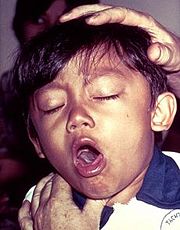Pertussis Toxin-ATP Complex
From Proteopedia
(Difference between revisions)
| Line 1: | Line 1: | ||
<StructureSection load=1bcp size='500' side='right' caption='Pertussis Toxin-ATP complex ([[1bcp]])' scene=''>[[Image:230px-Pertussis.jpg|left|thumb|A young boy coughing due to pertussis.]] | <StructureSection load=1bcp size='500' side='right' caption='Pertussis Toxin-ATP complex ([[1bcp]])' scene=''>[[Image:230px-Pertussis.jpg|left|thumb|A young boy coughing due to pertussis.]] | ||
==Introduction== | ==Introduction== | ||
| - | '''Pertussis Toxins''' (PT) is a protein-based exotoxin and major virulence factor produced by the bacterium [http://en.wikipedia.org/wiki/Bordetella_pertussis ''Bordetella pertussis''].<ref name=Hazes>PMID: 8637000</ref> PT causes [http://en.wikipedia.org/wiki/Whooping_cough pertussis], which is also known at whooping cough and is highly contagious bacterial disease. The disease is caused by the bacterium colonizing the respiratory tract where it then establishes an infection.<ref name=Carbonetti>PMID: 14573656</ref> This disease had been characterized by severe coughing that can last up to six weeks and in some countries lasting nearly 100 days.<ref name=Carbonetti>PMID: 17418639</ref>It has been documented in some cases that PT can cause [http://en.wikipedia.org/wiki/Subconjunctival_hemorrhage subconjunctival hemorrhages], [http://en.wikipedia.org/wiki/Rib_fracture rib fractures], [http://en.wikipedia.org/wiki/Hernias hernias], fainting and [http://en.wikipedia.org/wiki/Vertebral_artery_dissection vertebral artery dissection].<ref name=cornia>PMID: 20736473</ref> | + | '''Pertussis Toxins''' (PT) is a protein-based exotoxin and major virulence factor produced by the bacterium [http://en.wikipedia.org/wiki/Bordetella_pertussis ''Bordetella pertussis''].<ref name=Hazes>PMID: 8637000</ref> PT causes [http://en.wikipedia.org/wiki/Whooping_cough pertussis], which is also known at [http://proteopedia.org/wiki/index.php?title=Pertussis_Toxin-ATP_Complex&act whooping cough] and is highly contagious bacterial disease. The disease is caused by the bacterium colonizing the respiratory tract where it then establishes an infection.<ref name=Carbonetti>PMID: 14573656</ref> This disease had been characterized by severe coughing that can last up to six weeks and in some countries lasting nearly 100 days.<ref name=Carbonetti>PMID: 17418639</ref>It has been documented in some cases that PT can cause [http://en.wikipedia.org/wiki/Subconjunctival_hemorrhage subconjunctival hemorrhages], [http://en.wikipedia.org/wiki/Rib_fracture rib fractures], [http://en.wikipedia.org/wiki/Hernias hernias], fainting and [http://en.wikipedia.org/wiki/Vertebral_artery_dissection vertebral artery dissection].<ref name=cornia>PMID: 20736473</ref> |
As of 2010, the worldwide incidence of whooping cough has been estimated to 48.5 million cases and nearly 295,000 deaths per year.<ref name=Bettiol>PMID: 20091541</ref> With that in mind, whooping cough can affect people of any age; however, before vaccines were available the disease was most common in infants and young children but now children are immunized and the high percentage of cases are seen among adolescents. | As of 2010, the worldwide incidence of whooping cough has been estimated to 48.5 million cases and nearly 295,000 deaths per year.<ref name=Bettiol>PMID: 20091541</ref> With that in mind, whooping cough can affect people of any age; however, before vaccines were available the disease was most common in infants and young children but now children are immunized and the high percentage of cases are seen among adolescents. | ||
Revision as of 22:05, 15 November 2011
| |||||||||||
References
- ↑ 1.00 1.01 1.02 1.03 1.04 1.05 1.06 1.07 1.08 1.09 1.10 1.11 1.12 Hazes B, Boodhoo A, Cockle SA, Read RJ. Crystal structure of the pertussis toxin-ATP complex: a molecular sensor. J Mol Biol. 1996 May 17;258(4):661-71. PMID:8637000 doi:10.1006/jmbi.1996.0277
- ↑ 2.0 2.1 Carbonetti NH, Artamonova GV, Mays RM, Worthington ZE. Pertussis toxin plays an early role in respiratory tract colonization by Bordetella pertussis. Infect Immun. 2003 Nov;71(11):6358-66. PMID:14573656
- ↑ Cornia PB, Hersh AL, Lipsky BA, Newman TB, Gonzales R. Does this coughing adolescent or adult patient have pertussis? JAMA. 2010 Aug 25;304(8):890-6. PMID:20736473 doi:10.1001/jama.2010.1181
- ↑ Bettiol S, Thompson MJ, Roberts NW, Perera R, Heneghan CJ, Harnden A. Symptomatic treatment of the cough in whooping cough. Cochrane Database Syst Rev. 2010 Jan 20;(1):CD003257. PMID:20091541 doi:10.1002/14651858.CD003257.pub3
- ↑ Weiss AA, Johnson FD, Burns DL. Molecular characterization of an operon required for pertussis toxin secretion. Proc Natl Acad Sci U S A. 1993 Apr 1;90(7):2970-4. PMID:8464913
- ↑ 6.0 6.1 Kaslow HR, Burns DL. Pertussis toxin and target eukaryotic cells: binding, entry, and activation. FASEB J. 1992 Jun;6(9):2684-90. PMID:1612292
- ↑ Kenneth Todar, PhD. (2008). http://www.textbookofbacteriology.net/pertussis.html
- ↑ Plaut RD, Carbonetti NH. Retrograde transport of pertussis toxin in the mammalian cell. Cell Microbiol. 2008 May;10(5):1130-9. Epub 2007 Dec 31. PMID:18201245 doi:10.1111/j.1462-5822.2007.01115.x
- ↑ Kenneth Todar, PhD. (2008). http://www.textbookofbacteriology.net/pertussis.html
- ↑ Kenneth Todar, PhD. (2008). http://www.textbookofbacteriology.net/pertussis.html
- ↑ Centers for Disease Control and Prevention. http://www.cdc.gov/pertussis/clinical/treatment.html
- ↑ Altunaiji S, Kukuruzovic R, Curtis N, Massie J. Antibiotics for whooping cough (pertussis). Cochrane Database Syst Rev. 2007 Jul 18;(3):CD004404. PMID:17636756 doi:10.1002/14651858.CD004404.pub3
- ↑ Kenneth Todar, PhD. (2008). http://www.textbookofbacteriology.net/pertussis.html

